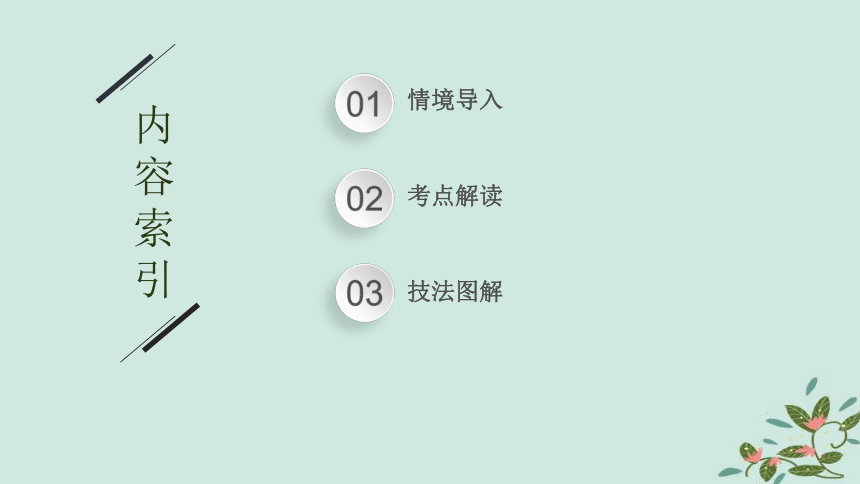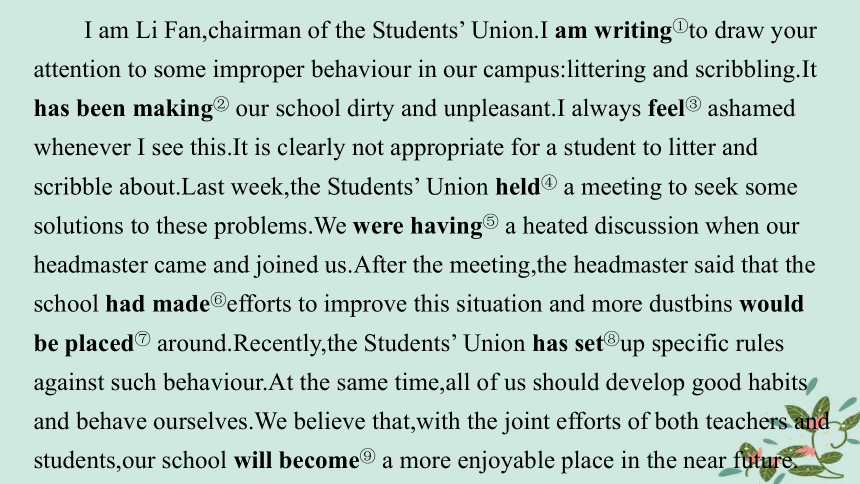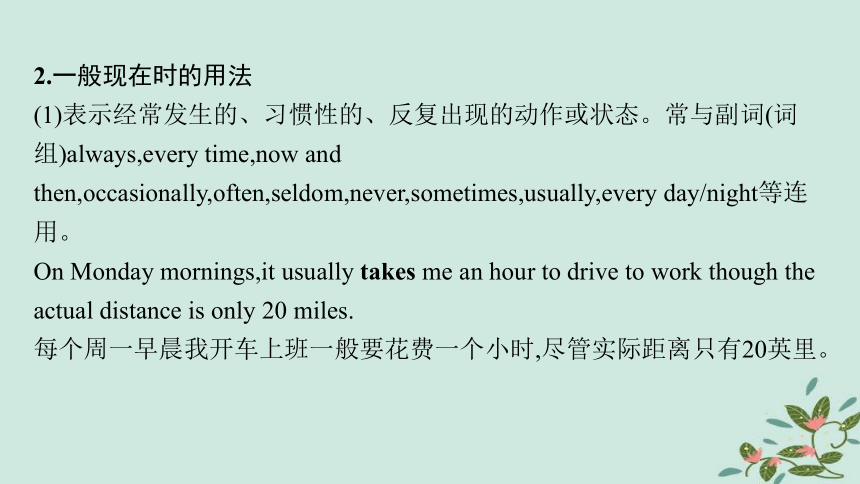2024届高考英语二轮总复习 语法专题突破 动词的时态和语态课件(共46张PPT)
文档属性
| 名称 | 2024届高考英语二轮总复习 语法专题突破 动词的时态和语态课件(共46张PPT) |

|
|
| 格式 | pptx | ||
| 文件大小 | 777.0KB | ||
| 资源类型 | 教案 | ||
| 版本资源 | 通用版 | ||
| 科目 | 英语 | ||
| 更新时间 | 2024-04-20 23:12:21 | ||
图片预览












文档简介
(共46张PPT)
第1讲 动词的时态和语态
内容索引
01
02
03
情境导入
考点解读
技法图解
情境导入
I am Li Fan,chairman of the Students’ Union.I am writing①to draw your attention to some improper behaviour in our campus:littering and scribbling.It has been making② our school dirty and unpleasant.I always feel③ ashamed whenever I see this.It is clearly not appropriate for a student to litter and scribble about.Last week,the Students’ Union held④ a meeting to seek some solutions to these problems.We were having⑤ a heated discussion when our headmaster came and joined us.After the meeting,the headmaster said that the school had made⑥efforts to improve this situation and more dustbins would be placed⑦ around.Recently,the Students’ Union has set⑧up specific rules against such behaviour.At the same time,all of us should develop good habits and behave ourselves.We believe that,with the joint efforts of both teachers and students,our school will become⑨ a more enjoyable place in the near future.
用法感悟
①是 时,结构为: 。
②是 时,结构为: 。
③是 时,结构为:
。
④是 时,结构为: 。
⑤是 时,结构为: 。
⑥是 时,结构为: 。
⑦是 语态,结构为: 。
⑧是 时,结构为: 。
⑨是 时,结构为: 。
现在进行
am/is/are+现在分词
现在完成进行
have/has been+现在分词
一般现在
谓语动词为动词原形或动词的第三人称单数形式
一般过去
谓语动词用动词的过去式形式
过去进行
was/were+现在分词
过去完成
had+过去分词
过去将来时的被动
would be+过去分词
现在完成
has/have+过去分词
一般将来
will+动词原形
考点解读
考点1 动词的时态
一、一般体
(一)一般现在时
1.一般现在时的构成
一般现在时主要由动词原形构成。be动词在第一人称单数后用am,第三人称单数后用is,其他人称后均用are。动词have的第三人称单数形式为has。实义动词的第三人称单数形式的变化规则如下:
变化规则 例词
一般情况直接加-s hate—hates
结尾为-s,-x,-sh,-ch或-o,在词尾加-es discuss—discusses
wash—washes fix—fixes
teach—teaches go—goes
结尾为“辅音字母+y”,变y为i再加-es carry—carries
study—studies
2.一般现在时的用法
(1)表示经常发生的、习惯性的、反复出现的动作或状态。常与副词(词组)always,every time,now and then,occasionally,often,seldom,never,sometimes,usually,every day/night等连用。
On Monday mornings,it usually takes me an hour to drive to work though the actual distance is only 20 miles.
每个周一早晨我开车上班一般要花费一个小时,尽管实际距离只有20英里。
(2)如果主句用一般将来时,那么在时间、条件或让步状语从句中,可用一般现在时表示将来。
The president hopes that the people will be better off when he quits.
这位总统希望人们在他离任时更富有。
(3)按时刻表、日程表等安排将要发生的动作或事件。常见的动词(词组)有go,arrive,leave,start,stay,return,begin,come,take off等。
Look at the timetable.Hurry up! Flight 4026 takes off at 18:20.
看看时刻表。快点儿吧!4026航班将在18:20起飞。
(二)一般过去时
1.一般过去时的构成
一般过去时由动词的过去式构成。规则动词的过去式的变化规则见下表:
变化规则 例词
一般情况在动词后加-ed prevent—prevented
以 -e结尾的动词后加-d like—liked
以“辅音字母+y”结尾的动词,变y为i再加-ed try—tried
以重读闭音节结尾,且词尾只有一个辅音字母的动词,双写该辅音字母再加-ed refer—referred
submit—submitted
2.一般过去时的用法
(1)表示过去一段时间内经常性或习惯性的动作。常与often,usually,seldom 等表示频率的副词连用。还可以表示在过去某一时间所发生的动作或存在的状态,与现在没有关系,常与yesterday,the other day,last week,the day before yesterday等表示过去的时间状语连用。
A few months after he had arrived in China,Mr.Smith fell in love with the people and culture there.
史密斯先生到中国几个月后就喜欢上了那里的人和文化。
(2)有些句子,虽然没有明确的表示过去的时间状语,但实际上指的是过去发生的动作或存在的状态,也要用一般过去时。常见的这类动词有know,think,expect,want等。
Edward,you play so well.But I didn’t know you could play the piano.
爱德华,你弹得真好。但是我原来不知道你会弹钢琴。
小题快练 单句语法填空
1.(2023新高考全国Ⅱ卷)As a little girl,I (wish) to be a zookeeper when I grew up.
2.(2023全国乙卷)The remarkable development of this city,which is consciously designed to protect the past while stepping into the modern world,
(mean) there is always something new to discover here,and I could be photographing Beijing for the next 50 years.
3.(2023浙江1月卷)The large siheyuan of these high-ranking officials and wealthy businessmen often (feature) beautifully carved and painted roof beams and pillars(柱子).
4.(2022全国乙卷)The chairman of the China Culture Promotion Society
(address) the opening ceremony.
wished
means
featured
addressed
二、 进行体
(一)进行时的构成
现在进行时由“am/is/are+现在分词”构成;过去进行时由“was/were+现在分词”构成;将来进行时由“will/shall+be+现在分词”构成。现在分词的变化规则如下表:
变化规则 例词
一般情况在词尾直接加-ing ask—asking
以不发音的e结尾的动词,去e再加-ing write—writing face—facing
以重读闭音节结尾,且末尾只有一个辅音字母的动词,双写该辅音字母再加-ing cut—cutting
begin—beginning
swim—swimming
以 -ie结尾的动词,变 -ie为y再加-ing lie—lying die—dying
(二)进行时的用法
1.现在进行时
(1)表示说话时正在进行或现阶段正在进行的动作,虽然此时此刻该动作不一定正在进行。
Today we are facing a strange new world and we are all wondering what we are going to do.
我们今天面对的是一个陌生的新世界,并且我们都想知道我们将要做什么。
(2)表示按计划或安排即将发生的动作,常见的动词有go,come,leave,start, arrive,return等。
Keep calm,please.I am arriving.
请保持镇静,我马上就到。
2.过去进行时
(1)表示过去某一时刻或某一段时间内正在进行的动作,常与表示过去的时间状语从句以及at that time,at that moment,at this time yesterday,at ten o’clock yesterday等连用。
He was writing a book last year,but I don’t know if he has finished it.
他去年在写一本书,但我不知道他是否已经完成了。
(2)表示一个过去的动作正在进行时,另一个过去的动作发生了,常与并列连词when连用。
Jack was working in the lab when the power cut occurred.
杰克正在实验室里工作,这时突然断电了。
3.将来进行时
表示将来某一时刻或某一时段正在发生或进行的动作,常与一些标志性的时间状语连用,如this time tomorrow,at that time,from 1:30 to 4:30 tomorrow等。
Jane can’t attend the meeting at 3 o’clock this afternoon because she will be teaching a class at that time.
简不能参加今天下午三点的会议,因为她那时有一堂课。
小题快练 单句语法填空
1.(2022新高考全国Ⅱ卷)Henry (fix) his car when he heard the screams.
2.That promise may be years away from realization but rapid typing enabled by bioprinting at present (push) medical advances forward at pace.
3.Given growing populations,increasing wealth,and the spreading popularity of natural remedies around the world,the demand for these medicines and remedies (rise) now.
was fixing
is pushing
is rising
4.Don’t call me between 8:00 and 10:00 tomorrow.I (have) my English class then.
5.When they arrived at Cheng’s place,the gatekeeper said the master
(take) a nap.
will be having
was taking
三、将来体
(一)一般将来时
1.一般将来时的构成
一般将来时由“shall/will+动词原形”构成。
2.一般将来时的用法
(1)表示从现在看将来要发生的动作或存在的状态,常与表示将来的时间状语tomorrow,next year,in+一段时间等连用。
The students have been working hard on their lessons and they will be rewarded with success in the future.
学生们一直在刻苦学习功课,他们将来会得到成功的回报。
(2)“will+动词原形”还可以表示说话时临时做出的决定。
—What time is it
——几点了
—I have no idea.But just a minute,I will check it for you.
——我不知道。但是你稍等一下,我给你查查。
3.其他表示“将来”的结构及用法
(1)“be going to+动词原形”表示按计划或打算要做某事或某种迹象预示着要发生某事。
Look! Dark clouds are gathering.It is going to rain soon,I think.
瞧!乌云正在聚集。 我想快要下雨了。
(2)“be to+动词原形”表示按计划或安排即将发生的动作;也可表示职责、义务、意图、禁止等。
You are to hand in your papers by 10 o’clock.
你们必须在10点前上交试卷。
(3)“be about to+动词原形”表示正要或即将要做某事,该结构不与表示具体时间的状语连用。
The train is about to start.火车就要开了。
(二)过去将来时
1.过去将来时的构成
过去将来时由“would+动词原形”构成。
2.过去将来时的用法
(1)表示从过去的某一时间来看将来(仍然是过去时间)要发生的动作或呈现的状态。
He said that he would never return.
他说他决不回来。
(2)表示过去的某种习惯性行为。
Whenever we had trouble,he would come to help us.
每当我们遇到困难时,他总会来帮助我们。
(3)表示强烈意愿。
I love my dog and I would never part from him.
我爱我的狗,决不愿和它分离。
小题快练 单句语法填空
1.However,experts believe that a cashless society does not mean that cash
(disappear) completely.
2.Albert Einstein was born in 1879,as a child,few people guessed that he
(be) a famous scientist whose theories would change the world.
3.If you give up in winter,you (miss) the hope of spring, the beauty of summer,and the harvest of autumn in your life.
will disappear
would be/was going to be
will miss
四、完成体
(一)现在完成时
(1)表示说话时已经完成的动作,但这个动作对现在仍有影响。常与already, just,yet等时间状语连用。
The manager has just left.If only you had come a moment earlier.
经理刚走,你要是能早来一会儿就好了。
(2)表示动作发生在过去,但一直延续至今(可能还要延续下去)。常与since+时间点,for+时间段等时间状语连用。
His first novel has received good reviews since it came out last month.
他的第一部小说自上个月出版以来获得了好评。
(3)在条件、时间等状语从句中,可用现在完成时表示将来某时间前已完成的动作。
I’ll give my opinion when I have read the book through.
我读完了这本书就会告诉你我的意见。
(二)过去完成时
(1)表示在过去某一时间或某一动作之前完成的动作,即“过去的过去”。句中一般有明确的表示“过去的过去”的时间状语(从句),但在语法填空题中很多时候需要通过上下文来判断。
When walking down the street,I came across David,whom I hadn’t seen for years.
当沿街散步的时候,我遇见了多年未见的戴维。
(2)表示从过去某一时间开始,一直延续到过去的另一时间的动作或状态,常用的时间状语有before,by that time,by the end of,by the time等。
By the end of June they had treated over 10,000 patients.
到六月底他们已治疗了一万多名病人。
(3)表示“希望、打算、认为”的动词(如hope,want,expect,think,mean,wish, plan,intend)用过去完成时表示过去本打算实现而未实现的愿望或计划。
I had hoped to send Peter a gift to congratulate him on his marriage,but I couldn’t manage it.
我本希望送给彼得一份礼物以祝贺他结婚,但我没能做到。
常使用完成时的句型
(1)This/It/That is the+序数词+time+that sb has/have done sth.
This/It/That was the+序数词+time+that sb had done sth.这/那是某人第几次做某事。
(2)It/This is/was the+形容词最高级+名词+(that)定语从句,从句中的谓语动词用现在/过去完成时。
(3)It is/has been+一段时间+since sb did sth.
It was/had been+一段时间+since sb had done sth.自从某人做某事以来多久了。
(4)在句型Hardly/Scarcely...when.../No sooner...than...中,主句用过去完成时,从句用一般过去时。
Hardly had I got home when the rain poured down.我刚到家,雨就倾盆而下。
(三) 现在完成进行时
1.现在完成进行时的构成
现在完成进行时由“have/has+been+v.-ing”构成。
2.现在完成进行时的用法
(1)常用来表示动作开始于过去某个时间,一直持续到现在并且可能会继续进行下去。
—You are a great swimmer.
——你游泳很棒。
—Thanks.It’s because I have been practising a lot these days.
——谢谢。这是因为这些天我一直在练习。
I’m very tired.I have been correcting the students’ papers all the morning.
我很累。我整个上午都在批改学生的试卷。
(2)表示到目前为止的一段时间里在反复进行的动作。
I have been calling him many times this morning,but there’s no answer.
今天早上我给他打了很多次电话,但都没有回应。
【点津】
现在完成时与现在完成进行时的区别:
现在完成时表示过去开始的一个动作到目前为止已经完成,体现动作的结果;现在完成进行时表示过去开始的一个动作到目前为止仍在进行,甚至仍将继续。
I’ve read Journey to the West.
我已经读过《西游记》了。(已经完成)
I have been reading Journey to the West these days.
这些天我一直在读《西游记》。(仍在进行甚至仍将继续)
小题快练 单句语法填空
1.On a website called No Fly Climate Sci,for example,roughly 200 academics—many of them are climate scientists— (promise) to fly as little as possible since the effort started two years ago.
2.(2021浙江卷)It doesn’t impress like George Washington’s plantation on the Potomac,but Lincoln’s home in downtown Springfield,Illinois,
(prove) irresistible to visitors since it opened to the public.
3.By the time Dale was a senior,he (win) every top honor in speech.
4.It (run) smoothly since 2020,as the world is facing the impact of the peace.
have promised
has proved/proven
had won
has run/has been running
考点2 动词的语态
一、各种时态的被动语态形式(以 do为例)
时态 一般式 进行式 完成式
现在时 am/is/are+done am/is/are+being+done have/has+been+done
过去时 was/were+done was/were+being+done had+been+done
将来时 shall/will be+done shall/will+have been+done
过去将 来时 would/should be+done would/should+have been+done
After school we went to the reading room to do some reading,only to be told that it was being decorated.(过去进行时的被动语态)
放学后,我们去阅览室看书,结果却被告知阅览室正在装修。
【点津】
(1)含有情态动词的谓语变为被动语态,由“情态动词(can,may,must,have to 等)+be+done”构成;
(2)含有be going to,be to,used to,be about to等结构的复合谓语变为被动语态,其构成为“be going to(be to,used to,be about to)+be+done”。
二、主动形式表示被动意义的几种情况
英语中有很多动词,如clean,sell,read,write,wash 等,当它们被用作不及物动词来描述主语特征时,常用其主动形式表示被动意义,主语通常是物;在这种情况下,常常和easily,well等副词连用。
This kind of cloth cleans easily.这种布料容易清洗。
【点津】
(1)主动语态表被动意义强调的是主语的特征,而被动语态则强调外界作用造成的影响。
(2)感官动词feel,sound,taste,look 等后跟形容词、名词构成系表结构,无被动形式。
(3)在need,want,require,deserve,bear 等动词,worth 等形容词的后面,动词-ing形式用主动形式表示被动意义,其含义相当于动词不定式的被动形式。
(4)在某些“主语(人/物)+be+形容词+动词不定式”中,动词不定式的主动形式表示被动意义。这些形容词有nice,easy,fit,hard,difficult,important, impossible,pleasant,interesting等。
The problem is difficult to work out.
这个问题很难解决。(可看作省略了for me)
(5)be to rent/blame也属于主动形式表被动意义。
Who is to blame for the mistake
谁应为这个错误承担责任
小题快练 单句语法填空
1.(2023全国乙卷)Having visited several times over the last 10 years,I
(amaze) by the co-existence of old and new,and how a city was able to keep such a rich heritage(遗产) while constantly growing.
2.(2023全国甲卷)Carson proves that a simple literary form that has been passed down through the ages can still (employ) today to draw attention to important truths.
3.(2021浙江卷)When the house was built,it was much smaller than it is today. Mary’s niece wrote,“The little home (paint)white.”
4.Also,Grain Rain (celebrate) by fishing villages in the coastal areas of northern China.
was amazed
be employed
was painted
is celebrated
技法图解
1.时态图解
【例1】 On Mondays and Fridays,she worked at a college giving students guidance so that they could have a good choice of career.On Tuesdays and Thursdays she helped out as a volunteer to give first aid to people without homes.And on weekends she (teach) local kids who needed extra help with their schoolwork.
分析:解本题时要运用语境综合判断法。根据上文“On Mondays and Fridays,she worked at a college giving students guidance so that they could have a good choice of career.On Tuesdays and Thursdays she helped out as a volunteer to give first aid to people without homes.”中的谓语动词可知此处应用一般过去时。
taught
【例2】 In the last 10 years or so,however,Traditional Chinese Medicine (TCM) (get) more popular all over the world.
分析:考查时态。解本题时要运用时间状语判断法。根据时间状语“In the last 10 years or so”可知,本句应用现在完成时。
has got
2.语态图解
【例1】 As the construction goes on,more roads (build) and the metro system will be expanded which can reduce traffic jams.
分析:解本题时要运用主谓关系判断法。根据“the metro system will be expanded”可知此处应用一般将来时。more roads与build之间为被动关系,因此用被动语态。
【例2】 Owing to the vast areas and large population of China,diverse dialects can (find) in this great land,such as the Wu dialect in Shanghai,Hakka and Cantonese.
分析:解本题时要注意句中的情态动词,且dialects与find之间为被动关系,根据“含有情态动词的被动语态”的结构可知答案。
will be built
be found
第1讲 动词的时态和语态
内容索引
01
02
03
情境导入
考点解读
技法图解
情境导入
I am Li Fan,chairman of the Students’ Union.I am writing①to draw your attention to some improper behaviour in our campus:littering and scribbling.It has been making② our school dirty and unpleasant.I always feel③ ashamed whenever I see this.It is clearly not appropriate for a student to litter and scribble about.Last week,the Students’ Union held④ a meeting to seek some solutions to these problems.We were having⑤ a heated discussion when our headmaster came and joined us.After the meeting,the headmaster said that the school had made⑥efforts to improve this situation and more dustbins would be placed⑦ around.Recently,the Students’ Union has set⑧up specific rules against such behaviour.At the same time,all of us should develop good habits and behave ourselves.We believe that,with the joint efforts of both teachers and students,our school will become⑨ a more enjoyable place in the near future.
用法感悟
①是 时,结构为: 。
②是 时,结构为: 。
③是 时,结构为:
。
④是 时,结构为: 。
⑤是 时,结构为: 。
⑥是 时,结构为: 。
⑦是 语态,结构为: 。
⑧是 时,结构为: 。
⑨是 时,结构为: 。
现在进行
am/is/are+现在分词
现在完成进行
have/has been+现在分词
一般现在
谓语动词为动词原形或动词的第三人称单数形式
一般过去
谓语动词用动词的过去式形式
过去进行
was/were+现在分词
过去完成
had+过去分词
过去将来时的被动
would be+过去分词
现在完成
has/have+过去分词
一般将来
will+动词原形
考点解读
考点1 动词的时态
一、一般体
(一)一般现在时
1.一般现在时的构成
一般现在时主要由动词原形构成。be动词在第一人称单数后用am,第三人称单数后用is,其他人称后均用are。动词have的第三人称单数形式为has。实义动词的第三人称单数形式的变化规则如下:
变化规则 例词
一般情况直接加-s hate—hates
结尾为-s,-x,-sh,-ch或-o,在词尾加-es discuss—discusses
wash—washes fix—fixes
teach—teaches go—goes
结尾为“辅音字母+y”,变y为i再加-es carry—carries
study—studies
2.一般现在时的用法
(1)表示经常发生的、习惯性的、反复出现的动作或状态。常与副词(词组)always,every time,now and then,occasionally,often,seldom,never,sometimes,usually,every day/night等连用。
On Monday mornings,it usually takes me an hour to drive to work though the actual distance is only 20 miles.
每个周一早晨我开车上班一般要花费一个小时,尽管实际距离只有20英里。
(2)如果主句用一般将来时,那么在时间、条件或让步状语从句中,可用一般现在时表示将来。
The president hopes that the people will be better off when he quits.
这位总统希望人们在他离任时更富有。
(3)按时刻表、日程表等安排将要发生的动作或事件。常见的动词(词组)有go,arrive,leave,start,stay,return,begin,come,take off等。
Look at the timetable.Hurry up! Flight 4026 takes off at 18:20.
看看时刻表。快点儿吧!4026航班将在18:20起飞。
(二)一般过去时
1.一般过去时的构成
一般过去时由动词的过去式构成。规则动词的过去式的变化规则见下表:
变化规则 例词
一般情况在动词后加-ed prevent—prevented
以 -e结尾的动词后加-d like—liked
以“辅音字母+y”结尾的动词,变y为i再加-ed try—tried
以重读闭音节结尾,且词尾只有一个辅音字母的动词,双写该辅音字母再加-ed refer—referred
submit—submitted
2.一般过去时的用法
(1)表示过去一段时间内经常性或习惯性的动作。常与often,usually,seldom 等表示频率的副词连用。还可以表示在过去某一时间所发生的动作或存在的状态,与现在没有关系,常与yesterday,the other day,last week,the day before yesterday等表示过去的时间状语连用。
A few months after he had arrived in China,Mr.Smith fell in love with the people and culture there.
史密斯先生到中国几个月后就喜欢上了那里的人和文化。
(2)有些句子,虽然没有明确的表示过去的时间状语,但实际上指的是过去发生的动作或存在的状态,也要用一般过去时。常见的这类动词有know,think,expect,want等。
Edward,you play so well.But I didn’t know you could play the piano.
爱德华,你弹得真好。但是我原来不知道你会弹钢琴。
小题快练 单句语法填空
1.(2023新高考全国Ⅱ卷)As a little girl,I (wish) to be a zookeeper when I grew up.
2.(2023全国乙卷)The remarkable development of this city,which is consciously designed to protect the past while stepping into the modern world,
(mean) there is always something new to discover here,and I could be photographing Beijing for the next 50 years.
3.(2023浙江1月卷)The large siheyuan of these high-ranking officials and wealthy businessmen often (feature) beautifully carved and painted roof beams and pillars(柱子).
4.(2022全国乙卷)The chairman of the China Culture Promotion Society
(address) the opening ceremony.
wished
means
featured
addressed
二、 进行体
(一)进行时的构成
现在进行时由“am/is/are+现在分词”构成;过去进行时由“was/were+现在分词”构成;将来进行时由“will/shall+be+现在分词”构成。现在分词的变化规则如下表:
变化规则 例词
一般情况在词尾直接加-ing ask—asking
以不发音的e结尾的动词,去e再加-ing write—writing face—facing
以重读闭音节结尾,且末尾只有一个辅音字母的动词,双写该辅音字母再加-ing cut—cutting
begin—beginning
swim—swimming
以 -ie结尾的动词,变 -ie为y再加-ing lie—lying die—dying
(二)进行时的用法
1.现在进行时
(1)表示说话时正在进行或现阶段正在进行的动作,虽然此时此刻该动作不一定正在进行。
Today we are facing a strange new world and we are all wondering what we are going to do.
我们今天面对的是一个陌生的新世界,并且我们都想知道我们将要做什么。
(2)表示按计划或安排即将发生的动作,常见的动词有go,come,leave,start, arrive,return等。
Keep calm,please.I am arriving.
请保持镇静,我马上就到。
2.过去进行时
(1)表示过去某一时刻或某一段时间内正在进行的动作,常与表示过去的时间状语从句以及at that time,at that moment,at this time yesterday,at ten o’clock yesterday等连用。
He was writing a book last year,but I don’t know if he has finished it.
他去年在写一本书,但我不知道他是否已经完成了。
(2)表示一个过去的动作正在进行时,另一个过去的动作发生了,常与并列连词when连用。
Jack was working in the lab when the power cut occurred.
杰克正在实验室里工作,这时突然断电了。
3.将来进行时
表示将来某一时刻或某一时段正在发生或进行的动作,常与一些标志性的时间状语连用,如this time tomorrow,at that time,from 1:30 to 4:30 tomorrow等。
Jane can’t attend the meeting at 3 o’clock this afternoon because she will be teaching a class at that time.
简不能参加今天下午三点的会议,因为她那时有一堂课。
小题快练 单句语法填空
1.(2022新高考全国Ⅱ卷)Henry (fix) his car when he heard the screams.
2.That promise may be years away from realization but rapid typing enabled by bioprinting at present (push) medical advances forward at pace.
3.Given growing populations,increasing wealth,and the spreading popularity of natural remedies around the world,the demand for these medicines and remedies (rise) now.
was fixing
is pushing
is rising
4.Don’t call me between 8:00 and 10:00 tomorrow.I (have) my English class then.
5.When they arrived at Cheng’s place,the gatekeeper said the master
(take) a nap.
will be having
was taking
三、将来体
(一)一般将来时
1.一般将来时的构成
一般将来时由“shall/will+动词原形”构成。
2.一般将来时的用法
(1)表示从现在看将来要发生的动作或存在的状态,常与表示将来的时间状语tomorrow,next year,in+一段时间等连用。
The students have been working hard on their lessons and they will be rewarded with success in the future.
学生们一直在刻苦学习功课,他们将来会得到成功的回报。
(2)“will+动词原形”还可以表示说话时临时做出的决定。
—What time is it
——几点了
—I have no idea.But just a minute,I will check it for you.
——我不知道。但是你稍等一下,我给你查查。
3.其他表示“将来”的结构及用法
(1)“be going to+动词原形”表示按计划或打算要做某事或某种迹象预示着要发生某事。
Look! Dark clouds are gathering.It is going to rain soon,I think.
瞧!乌云正在聚集。 我想快要下雨了。
(2)“be to+动词原形”表示按计划或安排即将发生的动作;也可表示职责、义务、意图、禁止等。
You are to hand in your papers by 10 o’clock.
你们必须在10点前上交试卷。
(3)“be about to+动词原形”表示正要或即将要做某事,该结构不与表示具体时间的状语连用。
The train is about to start.火车就要开了。
(二)过去将来时
1.过去将来时的构成
过去将来时由“would+动词原形”构成。
2.过去将来时的用法
(1)表示从过去的某一时间来看将来(仍然是过去时间)要发生的动作或呈现的状态。
He said that he would never return.
他说他决不回来。
(2)表示过去的某种习惯性行为。
Whenever we had trouble,he would come to help us.
每当我们遇到困难时,他总会来帮助我们。
(3)表示强烈意愿。
I love my dog and I would never part from him.
我爱我的狗,决不愿和它分离。
小题快练 单句语法填空
1.However,experts believe that a cashless society does not mean that cash
(disappear) completely.
2.Albert Einstein was born in 1879,as a child,few people guessed that he
(be) a famous scientist whose theories would change the world.
3.If you give up in winter,you (miss) the hope of spring, the beauty of summer,and the harvest of autumn in your life.
will disappear
would be/was going to be
will miss
四、完成体
(一)现在完成时
(1)表示说话时已经完成的动作,但这个动作对现在仍有影响。常与already, just,yet等时间状语连用。
The manager has just left.If only you had come a moment earlier.
经理刚走,你要是能早来一会儿就好了。
(2)表示动作发生在过去,但一直延续至今(可能还要延续下去)。常与since+时间点,for+时间段等时间状语连用。
His first novel has received good reviews since it came out last month.
他的第一部小说自上个月出版以来获得了好评。
(3)在条件、时间等状语从句中,可用现在完成时表示将来某时间前已完成的动作。
I’ll give my opinion when I have read the book through.
我读完了这本书就会告诉你我的意见。
(二)过去完成时
(1)表示在过去某一时间或某一动作之前完成的动作,即“过去的过去”。句中一般有明确的表示“过去的过去”的时间状语(从句),但在语法填空题中很多时候需要通过上下文来判断。
When walking down the street,I came across David,whom I hadn’t seen for years.
当沿街散步的时候,我遇见了多年未见的戴维。
(2)表示从过去某一时间开始,一直延续到过去的另一时间的动作或状态,常用的时间状语有before,by that time,by the end of,by the time等。
By the end of June they had treated over 10,000 patients.
到六月底他们已治疗了一万多名病人。
(3)表示“希望、打算、认为”的动词(如hope,want,expect,think,mean,wish, plan,intend)用过去完成时表示过去本打算实现而未实现的愿望或计划。
I had hoped to send Peter a gift to congratulate him on his marriage,but I couldn’t manage it.
我本希望送给彼得一份礼物以祝贺他结婚,但我没能做到。
常使用完成时的句型
(1)This/It/That is the+序数词+time+that sb has/have done sth.
This/It/That was the+序数词+time+that sb had done sth.这/那是某人第几次做某事。
(2)It/This is/was the+形容词最高级+名词+(that)定语从句,从句中的谓语动词用现在/过去完成时。
(3)It is/has been+一段时间+since sb did sth.
It was/had been+一段时间+since sb had done sth.自从某人做某事以来多久了。
(4)在句型Hardly/Scarcely...when.../No sooner...than...中,主句用过去完成时,从句用一般过去时。
Hardly had I got home when the rain poured down.我刚到家,雨就倾盆而下。
(三) 现在完成进行时
1.现在完成进行时的构成
现在完成进行时由“have/has+been+v.-ing”构成。
2.现在完成进行时的用法
(1)常用来表示动作开始于过去某个时间,一直持续到现在并且可能会继续进行下去。
—You are a great swimmer.
——你游泳很棒。
—Thanks.It’s because I have been practising a lot these days.
——谢谢。这是因为这些天我一直在练习。
I’m very tired.I have been correcting the students’ papers all the morning.
我很累。我整个上午都在批改学生的试卷。
(2)表示到目前为止的一段时间里在反复进行的动作。
I have been calling him many times this morning,but there’s no answer.
今天早上我给他打了很多次电话,但都没有回应。
【点津】
现在完成时与现在完成进行时的区别:
现在完成时表示过去开始的一个动作到目前为止已经完成,体现动作的结果;现在完成进行时表示过去开始的一个动作到目前为止仍在进行,甚至仍将继续。
I’ve read Journey to the West.
我已经读过《西游记》了。(已经完成)
I have been reading Journey to the West these days.
这些天我一直在读《西游记》。(仍在进行甚至仍将继续)
小题快练 单句语法填空
1.On a website called No Fly Climate Sci,for example,roughly 200 academics—many of them are climate scientists— (promise) to fly as little as possible since the effort started two years ago.
2.(2021浙江卷)It doesn’t impress like George Washington’s plantation on the Potomac,but Lincoln’s home in downtown Springfield,Illinois,
(prove) irresistible to visitors since it opened to the public.
3.By the time Dale was a senior,he (win) every top honor in speech.
4.It (run) smoothly since 2020,as the world is facing the impact of the peace.
have promised
has proved/proven
had won
has run/has been running
考点2 动词的语态
一、各种时态的被动语态形式(以 do为例)
时态 一般式 进行式 完成式
现在时 am/is/are+done am/is/are+being+done have/has+been+done
过去时 was/were+done was/were+being+done had+been+done
将来时 shall/will be+done shall/will+have been+done
过去将 来时 would/should be+done would/should+have been+done
After school we went to the reading room to do some reading,only to be told that it was being decorated.(过去进行时的被动语态)
放学后,我们去阅览室看书,结果却被告知阅览室正在装修。
【点津】
(1)含有情态动词的谓语变为被动语态,由“情态动词(can,may,must,have to 等)+be+done”构成;
(2)含有be going to,be to,used to,be about to等结构的复合谓语变为被动语态,其构成为“be going to(be to,used to,be about to)+be+done”。
二、主动形式表示被动意义的几种情况
英语中有很多动词,如clean,sell,read,write,wash 等,当它们被用作不及物动词来描述主语特征时,常用其主动形式表示被动意义,主语通常是物;在这种情况下,常常和easily,well等副词连用。
This kind of cloth cleans easily.这种布料容易清洗。
【点津】
(1)主动语态表被动意义强调的是主语的特征,而被动语态则强调外界作用造成的影响。
(2)感官动词feel,sound,taste,look 等后跟形容词、名词构成系表结构,无被动形式。
(3)在need,want,require,deserve,bear 等动词,worth 等形容词的后面,动词-ing形式用主动形式表示被动意义,其含义相当于动词不定式的被动形式。
(4)在某些“主语(人/物)+be+形容词+动词不定式”中,动词不定式的主动形式表示被动意义。这些形容词有nice,easy,fit,hard,difficult,important, impossible,pleasant,interesting等。
The problem is difficult to work out.
这个问题很难解决。(可看作省略了for me)
(5)be to rent/blame也属于主动形式表被动意义。
Who is to blame for the mistake
谁应为这个错误承担责任
小题快练 单句语法填空
1.(2023全国乙卷)Having visited several times over the last 10 years,I
(amaze) by the co-existence of old and new,and how a city was able to keep such a rich heritage(遗产) while constantly growing.
2.(2023全国甲卷)Carson proves that a simple literary form that has been passed down through the ages can still (employ) today to draw attention to important truths.
3.(2021浙江卷)When the house was built,it was much smaller than it is today. Mary’s niece wrote,“The little home (paint)white.”
4.Also,Grain Rain (celebrate) by fishing villages in the coastal areas of northern China.
was amazed
be employed
was painted
is celebrated
技法图解
1.时态图解
【例1】 On Mondays and Fridays,she worked at a college giving students guidance so that they could have a good choice of career.On Tuesdays and Thursdays she helped out as a volunteer to give first aid to people without homes.And on weekends she (teach) local kids who needed extra help with their schoolwork.
分析:解本题时要运用语境综合判断法。根据上文“On Mondays and Fridays,she worked at a college giving students guidance so that they could have a good choice of career.On Tuesdays and Thursdays she helped out as a volunteer to give first aid to people without homes.”中的谓语动词可知此处应用一般过去时。
taught
【例2】 In the last 10 years or so,however,Traditional Chinese Medicine (TCM) (get) more popular all over the world.
分析:考查时态。解本题时要运用时间状语判断法。根据时间状语“In the last 10 years or so”可知,本句应用现在完成时。
has got
2.语态图解
【例1】 As the construction goes on,more roads (build) and the metro system will be expanded which can reduce traffic jams.
分析:解本题时要运用主谓关系判断法。根据“the metro system will be expanded”可知此处应用一般将来时。more roads与build之间为被动关系,因此用被动语态。
【例2】 Owing to the vast areas and large population of China,diverse dialects can (find) in this great land,such as the Wu dialect in Shanghai,Hakka and Cantonese.
分析:解本题时要注意句中的情态动词,且dialects与find之间为被动关系,根据“含有情态动词的被动语态”的结构可知答案。
will be built
be found
